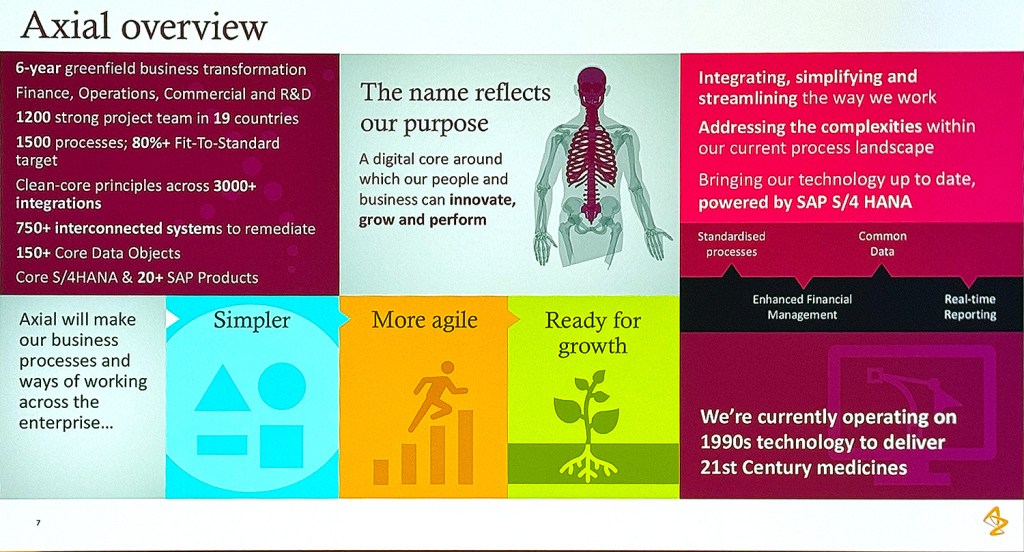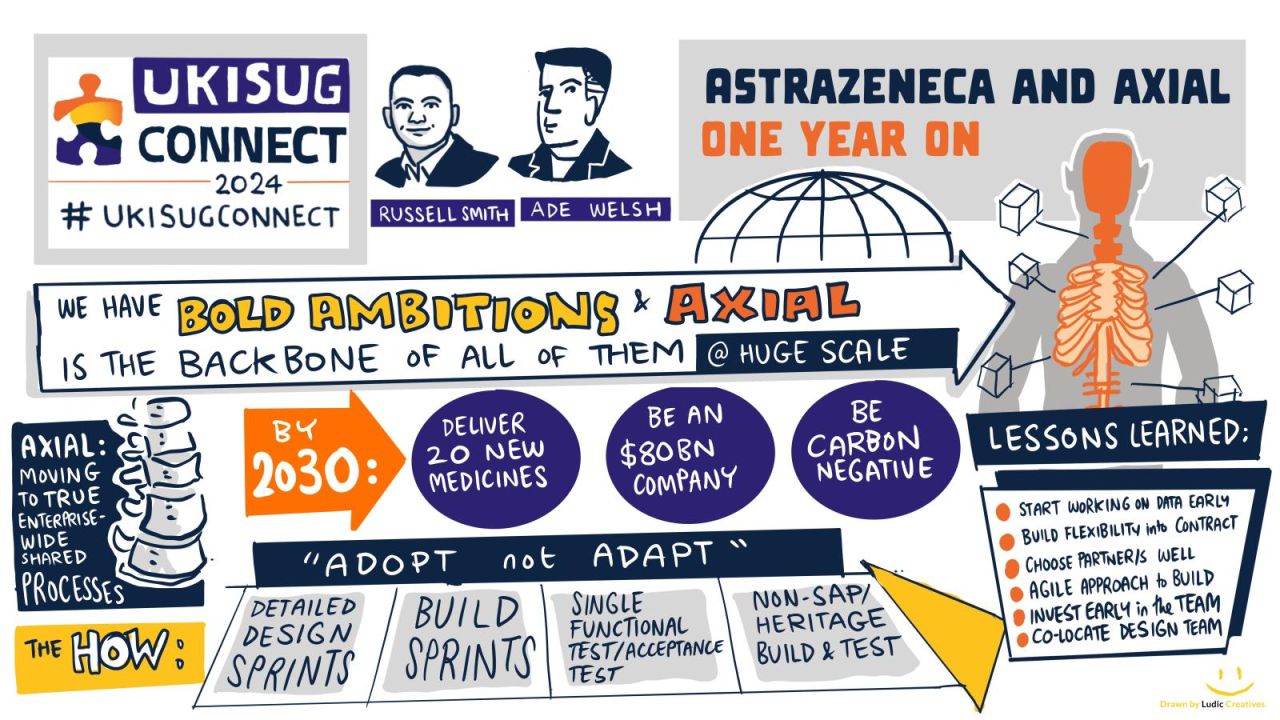At UKISUG Connect 2024, AstraZeneca charted their plans for the future, with some help from SAP. Russell Smith, Vice President ERP Transformation and Ade Welsh, Senior Director, Head Of Solution Design & Delivery gave the keynote presentation at the Birmingham event.

AstraZeneca is a global biopharmaceutical leader headquartered in Cambridge, UK, AstraZeneca operates in over 100 countries, with a robust presence across five global R&D centers and 27 manufacturing sites, and around 90,000 employees. Serving millions of patients annually, AstraZeneca’s commitment to sustainability and growth through innovation underpins its ambitious vision to pioneer advancements in healthcare and improve lives worldwide.
Axial: The Strategic Backbone for Bold Ambition 2030

At the heart of AstraZeneca’s Bold Ambition 2030 lies “Axial”, an ambitious initiative to modernize its operations and propel the pharmaceutical giant toward industry leadership.
“We’re currently operating on 1990s technology to deliver 21st Century medicines”
The Axial Business Transformation Program represents the largest SAP project in Europe, aiming to simplify and unify a complex global business through a groundbreaking greenfield implementation of SAP S/4HANA. This six-year endeavor reflects AstraZeneca’s commitment to integrating innovation, growth, and sustainability across its global operations.
Innovation Beyond Technology
The Axial program is aptly named, reflecting its role as a “digital backbone” for AstraZeneca, akin to the human axial skeleton. It underpins the company’s three key objectives for 2030:
- Delivering 20 new medicines: This ambitious target aims to address unmet medical needs and accelerate patient outcomes in a sector where developing a single drug can take over a decade.
- Achieving $80 billion in revenue: With current revenues of $45 billion, Axial is integral to scaling operations efficiently.
- Becoming carbon negative: Investments in SAP technology will also aid AstraZeneca in tracking and managing its carbon footprint.
Axial’s transformation isn’t just about technology. It’s also about embracing a cultural shift toward enterprise-wide process standardization: by establishing a unified taxonomy and integrating 750 legacy systems, AstraZeneca aims to break down silos and fostering an agile, collaborative environment. The company’s focus on end-to-end process design ensures seamless integration across its value chain.
The Scale of Transformation
The Axial initiative exemplifies the enormity of modern enterprise transformations:
- Global Scope: A team of 1,200 professionals in 19 countries is working to transform operations spanning 27 manufacturing sites and five R&D hubs.
- Technology Integration: It involves 750 interconnected systems and 3,000+ integrations, with 150 core data objects forming the foundation of a fit-to-standard process model.
- End-to-End Processes: The program covers 1,500 processes across finance, operations, R&D, and commercial functions, with an 80%+ fit-to-standard target.
- Greenfield Approach: Building a clean digital core, the program moves AstraZeneca away from 1990s technology to a streamlined, future-ready platform.
The project also embraces SAP’s new life sciences modules and advanced capabilities like intelligent clinical supply management, ensuring that innovation extends beyond the digital core.

The Lessons Learned: Insights for Enterprise Leaders
As AstraZeneca moves into 2025, the Axial program will focus on global testing phases and initial deployments. Here are the key lessons learned so far:

1. Start Data Management Early—Really Early
“Whenever you start working on data, it’s always too late,” emphasized Russell Smith. Despite implementing Master Data Governance (MDG) before starting the S/4HANA rollout, AstraZeneca faced massive challenges with data inconsistencies. For instance, over a third of their business partner records had duplications across legacy systems, each with slight variations.
Key Takeaways:
- Invest in Cleansing and Harmonization: Harmonizing and renumbering data across 750 interconnected systems proved to be a monumental task. Early data governance frameworks and tools like Syniti helped but required more lead time than anticipated.
- Start Data Work Immediately: Even before formal project kickoffs, organizations should prioritize identifying, cleansing, and validating data to avoid costly delays later.
2. Build Flexibility into SAP Contracts
AstraZeneca’s initial SAP contract didn’t fully anticipate the program’s evolving needs. Over time, changing priorities, shifting business volumes, and new discoveries made parts of the original agreement less relevant.
Key Takeaways:
- Plan for Uncertainty: Build flexibility into software contracts, allowing for adjustments in volume, scope, and functionality.
- Accept Change as Inevitable: As Smith noted, “The only day a contract is good is the day you sign it.” Organizations must embrace adaptability and allocate contingency budgets for unforeseen requirements.
3. Choose Partners Who Will Challenge You
AstraZeneca broke from convention by selecting a non-incumbent partner with a contrasting culture. This decision was deliberate: they wanted a partner that would push them out of their comfort zone. “We needed tough love to make faster decisions,” Smith remarked.
Key Takeaways:
- Prioritize Fit Over Familiarity: Avoid defaulting to existing partners unless they demonstrate the ability to challenge your organization constructively.
- Engage SAP Deeply: AstraZeneca found unexpected value in SAP’s MaxAttention services, which provided critical support for complex design and technical decisions.
4. Adopt an Agile Approach to Build
Traditionally, organizations complete design phases before starting development. However, Axial adopted a parallel approach, overlapping detailed design and build phases. This approach accelerated timelines but introduced some risk.
Key Takeaways:
- Be Willing to Take Smart Risks: Parallel execution requires careful prioritization and readiness to handle minor rework. AstraZeneca’s experience shows that the gains in speed often outweigh the costs.
- Leverage Hybrid Teams: Combining internal expertise with external partners ensured faster decision-making and seamless integration.
5. Invest in People Early
Finding the right talent—both internally and externally—was one of Axial’s most critical success factors. AstraZeneca treated this transformation as a once-in-a-generation opportunity, marketing the program to employees to attract top talent.
Key Takeaways:
- Prioritize Internal Selling: Highlight the career-defining opportunities of transformation projects to secure the best internal talent.
- Plan for Backfills: Freeing key team members required proactive backfilling, which took longer than anticipated. Early planning and alignment with leadership are essential.
- Recruit Externally for Gaps: Relying solely on internal teams or system integrators may not suffice. AstraZeneca successfully sought niche skills from the marketplace.
6. Co-Locate Core Design Teams
AstraZeneca’s core design team operated from two centralized locations—Macclesfield and Luton—allowing for face-to-face collaboration that significantly enhanced productivity.
Key Takeaways:
- Centralize Core Teams: For critical design phases, physical co-location fosters better communication and faster decision-making.
- Embrace Remote Tools for Localization: While core design benefited from in-person collaboration, localization workshops were effectively conducted remotely, using facilitation technologies.
Final Reflections

The lessons from AstraZeneca’s Axial transformation underscore the complexity and scale of modern enterprise projects. From data management to agile methodologies and partner selection, the insights shared by Smith and Welsh serve as a roadmap for organizations embarking on similar journeys.
By addressing challenges proactively and embracing flexibility, AstraZeneca is not just transforming its operations but setting a benchmark for how enterprises can innovate at scale. For leaders seeking to navigate their own transformations, these lessons are both timely and transformative.
